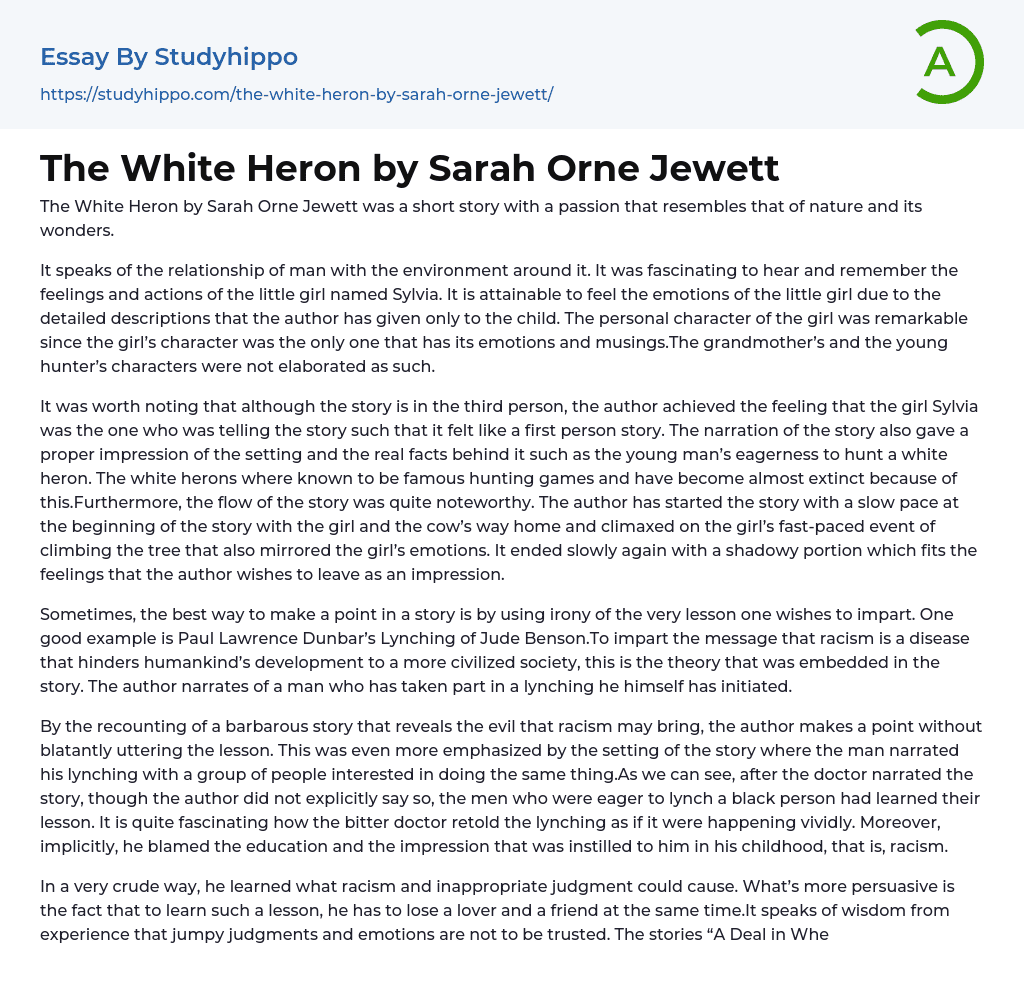"The White Heron" by Sarah Orne Jewett is a brief narrative that emanates a fervor akin to nature and its wonders.
The text discusses the connection between humans and their surrounding environment. The author's vivid descriptions solely focus on the emotions and actions of a young girl named Sylvia, making it easy for readers to empathize with her. The unique personality of Sylvia stands out as she is the only character who has been given detailed thoughts and feelings, while the grandmother and young hunter remain relatively undeveloped.
In the third-person narrative, the author effectively established Sylvia as the first-person storyteller of the tale. The pacing of the story was noteworthy, starting with Sylvia and a cow's journey home at a slow pace, gradually building up to her emotional tree-climbing climax, and concluding with a hauntingly mysteri
...ous portion that had a lasting impact. Additionally, essential information about the setting and facts were conveyed through narration; for instance, it was revealed that hunting of white herons had almost led to their extinction and that a young man was eager to hunt them.
Utilizing irony can be an efficient method of communicating a message in literature. This is exemplified in Paul Lawrence Dunbar's Lynching of Jude Benson, which seeks to demonstrate that racism impedes the advancement of humanity towards civility. The author accomplishes this by recounting the story of a man who instigates and partakes in a lynching despite being aware of its immorality.
Through a barbarous tale about the consequences of racism, the author skillfully delivers a message without stating it outright. The setting of the story - with a group of individuals eager to commit a lynchin
- only emphasizes this point further. Despite the author's lack of explicit commentary, it is clear that the audience learned a lesson after hearing the doctor's vivid retelling of his own lynching. Additionally, the doctor subtly implicates his childhood education and upbringing for instilling racist beliefs in him.
Through losing a loved one and a friend, he learned firsthand the negative impact of racism and misjudgment. This taught him the importance of avoiding quick emotions and judgments. The stories "A Deal in Wheat" by Frank Norris and "Shifts of the Poor" by Theodore Dreiser both explore the stark divide between society's wealthy and impoverished classes. Both tales emphasize the contrasting fate of these two groups, showcasing their vast differences.
The text examines the increasing social divide between those who are financially well-off and those who are not, emphasizing the influence that the affluent have over their less privileged peers. Two different stories, each taking place in a distinct location and exploring diverse tactics for gaining power, delve into this theme. Dreiser's narrative is situated in an urban environment where it portrays the extreme destitution experienced by a former manager who must survive on the streets while enduring hunger and homelessness.
Despite being initially alone and portrayed negatively through descriptive adjectives, the ex-manager's story of poverty was just one among many, as revealed by the author. In contrast, Norris depicted poverty through farmers who were reduced to a meager state by wealthy individuals controlling the wheat market like a cartel. While Dreiser's story was predominantly set in the city, Norris' included a rural area, providing a unique perspective on the theme of poverty in both stories.
- Overpopulation essays
- Homelessness essays
- Hunger essays
- Dumpster Diving essays
- Homelessness In America essays
- Malcolm X essays
- Black Lives Matter essays
- Antisemitism essays
- Ku Klux Klan essays
- Miscegenation essays
- Racial Segregation essays
- I Have a Dream essays
- Martin Luther King essays
- Racial Inequality essays
- Black History Month essays
- Black People essays
- John Locke essays
- 9/11 essays
- A Good Teacher essays
- A Healthy Diet essays
- A Modest Proposal essays
- A&P essays
- Academic Achievement essays
- Achievement essays
- Achieving goals essays
- Admission essays
- Advantages And Disadvantages Of Internet essays
- Alcoholic drinks essays
- Ammonia essays
- Analytical essays
- Ancient Olympic Games essays
- APA essays
- Arabian Peninsula essays
- Argument essays
- Argumentative essays
- Art essays
- Atlantic Ocean essays
- Auto-ethnography essays
- Autobiography essays
- Ballad essays
- Batman essays
- Binge Eating essays
- Black Power Movement essays
- Blogger essays
- Body Mass Index essays
- Book I Want a Wife essays
- Boycott essays
- Breastfeeding essays
- Bulimia Nervosa essays
- Business essays




